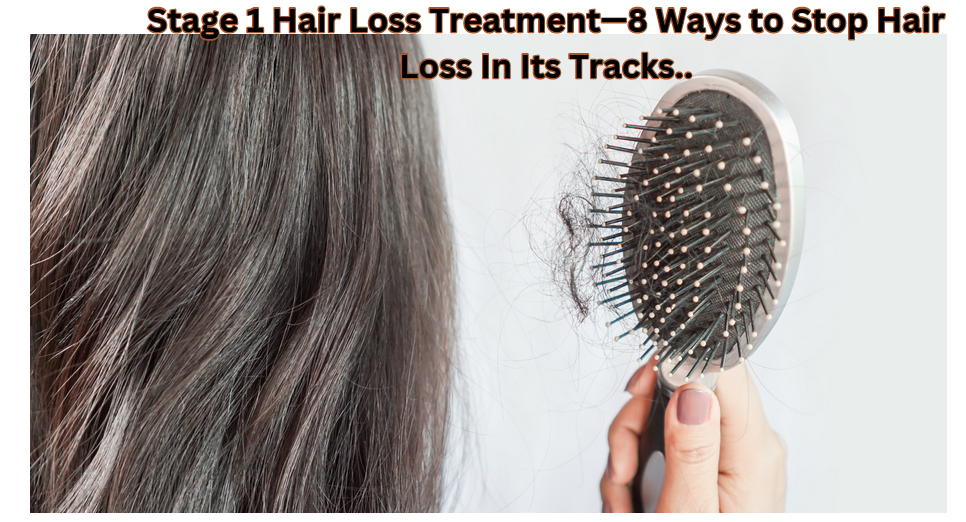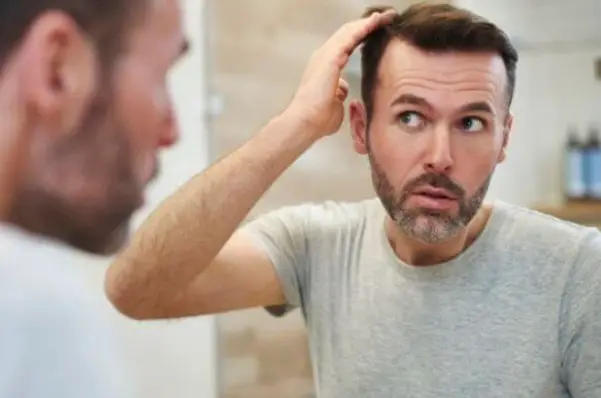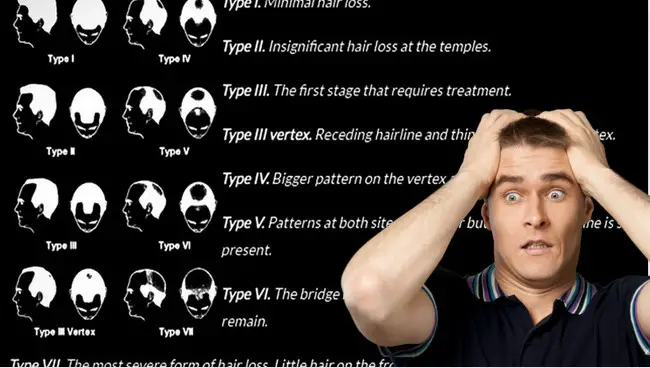Welcome to our comprehensive guide on Stage 1 Hair Loss Treatment. If you’ve noticed a few more hairs in your comb or on your pillow and are wondering what’s going on, you’re in the right place. Hair loss is a common concern for many people, and understanding it is the first step towards effective treatment.
In this article, we’ll delve into the topic of stage 1 hair loss, exploring its causes, symptoms, and most importantly, the solutions. We’ll discuss both male and female hair loss, as the two can present differently and may require different approaches to treatment.
We’ll also talk about the importance of early intervention. Catching hair loss in its early stages, such as stage 1, can make a significant difference in the outcome of your treatment. The sooner you start, the better your chances of slowing down the progression and even regrowing your hair.
Whether you’re looking for ways to stop hair fall immediately or curious about how to regrow hair naturally in 3 weeks, we’ve got you covered. We’ll discuss various treatment options, from over-the-counter products to prescription medications, and even lifestyle changes that can help.
This guide is designed to be your one-stop resource for all things related to stage 1 hair loss treatment. So, if you’re ready to take control of your hair health, keep reading.
Key takeaways
Here are the key takeaways from the blog post:
- Early Intervention is Key: Stage 1 hair loss is characterized by little to no hair loss or hairline recession. The key to managing this stage is early intervention.
- Over-the-Counter Treatments: Over-the-counter treatments like minoxidil and hair loss shampoos can be effective for stage 1 hair loss. Natural oils like castor oil and rosemary oil can also be beneficial.
- Prescription Treatments: If over-the-counter treatments aren’t effective, prescription treatments like finasteride and spironolactone may be recommended. These should only be used under the guidance of a healthcare provider.
- Lifestyle Changes and Natural Remedies: Lifestyle changes like improving your diet and managing stress can help combat hair loss. Natural remedies like scalp massages and certain herbs can also promote hair growth.
- Consult a Healthcare Provider: If you’re unsure about the cause of your hair loss or the best treatment for you, it’s always a good idea to consult a healthcare provider. They can provide a professional diagnosis and guide you towards the most effective treatment options for your specific situation.
Remember, the goal is to maintain the health of your existing hair and prevent further hair loss. With the right treatment and care, you can manage stage 1 hair loss effectively. For more information, check out our comprehensive guides on Norwood Scale and Early Stages of Balding Crown.
And remember, while this guide is comprehensive, it’s always a good idea to consult with a healthcare provider for personalized advice. Now, let’s dive in and start with understanding what exactly stage 1 hair loss is.
Related Post: Stage 2 Hair Loss Treatment
Understanding Hair Loss
Hair loss is a common concern that affects both men and women at various stages of life. It can be a distressing experience, but the good news is that understanding the causes and stages of hair loss can help you take proactive steps towards treatment.
What is Stage 1 Hair Loss?
Stage 1 hair loss is the earliest stage of hair loss. At this stage, the hair loss is minimal and often unnoticeable to others. For men, it might manifest as a slight recession in the hairline, particularly around the temples. Women, on the other hand, may notice a general thinning of hair, especially at the parting.
It’s crucial to catch hair loss at this stage, as early intervention can significantly slow down its progression. If you’re unsure whether you’re experiencing stage 1 hair loss, consider consulting a dermatologist or a trichologist for a professional diagnosis.
Learn more about the different stages of hair loss in our comprehensive guide on Stages of Balding.
Causes of Stage 1 Hair Loss
Hair loss can be caused by a variety of factors. Here are some of the most common ones:
- Genetic Factors: Hereditary hair loss, also known as androgenetic alopecia, is the most common cause of hair loss. If your parents or grandparents experienced hair loss, you might be genetically predisposed to it as well.
- Hormonal Changes: Hormonal imbalances can lead to hair loss. This is particularly common in women during menopause or after childbirth.
- Lifestyle Factors: Poor nutrition, stress, lack of sleep, and certain hairstyles can contribute to hair loss.
- Vitamin Deficiencies: Deficiencies in certain vitamins, such as vitamin D and B vitamins, can lead to hair loss.
Learn more about the role of vitamins in hair health in our article on Which Vitamin Deficiency Causes Hair Loss, and understanding what’s the real cause of hair loss.
How to Identify Stage 1 Hair Loss
Identifying stage 1 hair loss early on can make a significant difference in the effectiveness of your treatment. Here are some signs to look out for:
- Slight Recession of the Hairline: This is particularly noticeable around the temples.
- Increased Hair Shedding: While it’s normal to lose a few hairs every day, if you notice an increase in hair shedding, it might be a sign of stage 1 hair loss.
- Thinning Hair: If your hair feels thinner than usual or if you notice more scalp showing when your hair is parted, it could be a sign of stage 1 hair loss.
If you’re unsure whether you’re experiencing stage 1 hair loss, it’s always a good idea to consult a healthcare provider. Check out our guide on How to Tell If You’re Balding for more information.
The Consequences of Denial: From Stage 1 to Stage 2 Hair Loss
When it comes to hair loss, denial can be a dangerous game. It’s easy to dismiss the early signs of hair loss, to convince ourselves that it’s just a temporary issue or that it’s not as bad as it seems. But the truth is, ignoring stage 1 hair loss can lead to more advanced stages of hair loss, including stage 2 hair loss and beyond.
At stage 1, hair loss is often minimal and can be effectively managed with over-the-counter treatments and lifestyle changes. But as hair loss progresses to stage 2 and beyond this point, it becomes more noticeable and more difficult to treat.
Suppose you ignore the signs of stage 1 hair loss and allow it to progress to stage 2. In that case, you may face more drastic and expensive treatment options, such as hair transplants and low-level laser (light) therapy (lllt) for hair loss treatment, e.g., laser hair growing caps, laser comb and laser helmet. These treatments can be effective but also have potential side effects and a significant financial cost.
Moreover, advanced stages of hair loss can have a significant impact on your self-esteem and mental health. Many people with hair loss report feelings of embarrassment, self-consciousness, and even depression.
The bottom line is this: early intervention is crucial. If you notice the first signs of hair loss, don’t ignore them. Take action. Start with gentle, natural treatments like scalp massages, hair loss shampoos, and lifestyle changes. If these aren’t effective, consult a healthcare provider for further guidance.
Remember, the goal is not just to prevent hair loss, but to maintain the health of your existing hair and your overall well-being. Don’t let denial stand in the way of taking action.
Check out our guide on Early Stages of Balding Crown to learn more about the early signs of hair loss and the importance of early intervention.
Progression of Hair Loss: From Stage 1 to Stage 2
If left untreated, stage 1 hair loss can progress to stage 2. In stage 2, the hair loss becomes more noticeable, with a more pronounced recession of the hairline in men and increased thinning in women.
The good news is that with early intervention, it’s possible to slow down or even halt the progression of hair loss. The key is to start treatment as soon as you notice the first signs of hair loss.
Learn more about the progression of hair loss in our guide on Male Pattern Baldness Stages.
Treatment Options for Stage 1 Hair Loss
When it comes to treating stage 1 hair loss, early intervention is key. At this stage, there is little to no hair loss or hairline recession, so invasive treatments like hair transplants and laser treatments are not necessary. Instead, the focus should be on maintaining the health of your existing hair and preventing further hair loss. Here are some strategies to consider:
Over-the-Counter Treatments
Over-the-counter (OTC) treatments can be a good starting point for treating stage 1 hair loss. Here are some of the most popular ones:
- Minoxidil (Rogaine): This topical treatment is applied directly to the scalp. It works by prolonging the growth phase of hair follicles, leading to thicker and longer hair.
- Hair Loss Shampoos and Conditioners: These products are formulated with ingredients that can help reduce hair loss and promote hair growth. They can be a convenient addition to your hair care routine. However, it’s important to choose a shampoo that is gentle and free of harsh chemicals, as these can cause more hair loss. We recommend our More Hair Organic Shampoo, which is made with natural ingredients that nourish the scalp and hair.
- Natural Oils: Oiling the scalp can help to nourish the hair follicles and promote hair growth. Certain natural oils, such as castor oil and rosemary oil, have been found to be particularly beneficial.
Lifestyle Changes and Natural Remedies
In addition to OTC treatments, making certain lifestyle changes and trying natural remedies can also help combat hair loss. Here are some strategies to consider:
- Diet and Nutrition: Eating a balanced diet rich in vitamins and minerals can support hair health. Consider incorporating foods rich in omega-3 fatty acids, protein, and biotin into your diet. Supplements like Biotin Gummies or It Really Works Vitamins Best Supplements for Hair Growth can also be beneficial.
- Exercise and Stress Management: Regular exercise can help reduce stress, which can contribute to hair loss. Practices like yoga and meditation can also help manage stress levels.
- Herbs That Stimulate Hair Growth: Certain herbs, such as rosemary and ginseng, have been found to stimulate hair growth and can be used as natural remedies.
Learn more about the benefits of natural oils for hair growth in our comparison of Jamaican Black Castor Oil vs Castor Oil for Hair Growth.
Prescription Treatments
While stage 1 hair loss is often effectively managed with over-the-counter treatments and lifestyle changes, there may be situations where prescription treatments are recommended. These are typically used when hair loss is due to specific medical conditions or hormonal imbalances. Here are a couple of options:
Finasteride (Propecia)
Finasteride, sold under the brand name Propecia, is an oral medication that is typically used in men with male pattern baldness. It works by blocking the production of a hormone called dihydrotestosterone (DHT), which is known to contribute to hair loss. By reducing the levels of DHT, finasteride can slow down hair loss and even promote hair regrowth in some cases.
It’s important to note that while finasteride can be effective, it also comes with potential side effects, including sexual dysfunction and mood changes. Therefore, it should only be used under the guidance of a healthcare provider.
Spironolactone (Carospir, Aldactone) and Oral Dutasteride (Avodart)
For women experiencing hair loss due to hormonal imbalances, medications like spironolactone and oral dutasteride may be recommended. Spironolactone works by blocking the effects of androgens (male hormones) that can contribute to hair loss in women. Dutasteride, like finasteride, works by blocking the production of DHT.
As with all prescription medications, these treatments come with potential side effects and should only be used under the guidance of a healthcare provider.
A recommendation alternative is using:
The Importance of Professional Guidance
Remember, while prescription treatments can be effective, they should only be used under the guidance of a healthcare provider. Hair loss can be a symptom of underlying health issues, so it’s important to get a proper diagnosis before starting any new treatment.
If you’re experiencing hair loss and are unsure about the next steps, consider consulting a healthcare provider or a trichologist, a specialist in scalp and hair health. They can provide a professional diagnosis and guide you towards the most effective treatment options for your specific situation.
Learn more about the early stages of hair loss in our guide on Is Norwood 1 Balding?.
FAQs: About Stage 1 Hair Loss Treatment
In this section, we’ll answer some of the most common questions about stage 1 hair loss treatment.
What is the best treatment for stage 1 hair loss?
The best treatment for stage 1 hair loss depends on the cause of your hair loss, your lifestyle, and your personal preferences. Over-the-counter treatments like minoxidil and hair loss shampoos can be effective, as can lifestyle changes like improving your diet and managing stress. If these treatments aren’t effective, your healthcare provider might recommend prescription treatments.
Can stage 1 hair loss be reversed?
Yes, in many cases, stage 1 hair loss can be reversed or at least slowed down. The key is early intervention. If you notice the first signs of hair loss, it’s important to start treatment as soon as possible.
How can I regrow thinning hair naturally?
There are several natural strategies that can help promote hair regrowth. These include oiling the scalp, using gentle hair care products, eating a balanced diet, managing stress, and using certain herbs that stimulate hair growth.
What vitamins should I take for hair loss?
Certain vitamins, such as vitamin D and B vitamins, are important for hair health. If you’re experiencing hair loss, you might benefit from a supplement that includes these vitamins. However, it’s always a good idea to consult a healthcare provider before starting any new supplement regimen.
Conclusion
Stage 1 hair loss can be a distressing experience, but remember, you’re not alone. Many people experience hair loss at some point in their lives, and there are many treatments available that can help. The key is to catch hair loss early and start treatment as soon as possible. With the right treatment and care, you can maintain the health of your hair and prevent further hair loss.
Remember, if you’re unsure about the cause of your hair loss or the best treatment for you, it’s always a good idea to consult a healthcare provider. They can provide a professional diagnosis and guide you towards the most effective treatment options for your specific situation.
For more information on hair loss and its treatments, check out our comprehensive guides on Crown Balding Stages and Male Pattern Baldness Stages Time.
- AI Powered Bald Filter Online 2024: See Yourself with No Hair! - January 19, 2024
- Harklinikken Bad Reviews 2024: Analyzing Negative Feedbacks - January 18, 2024
- How to Get the Alex Eubank Hair | Step-By-Step Tutorial 2024 - January 18, 2024







